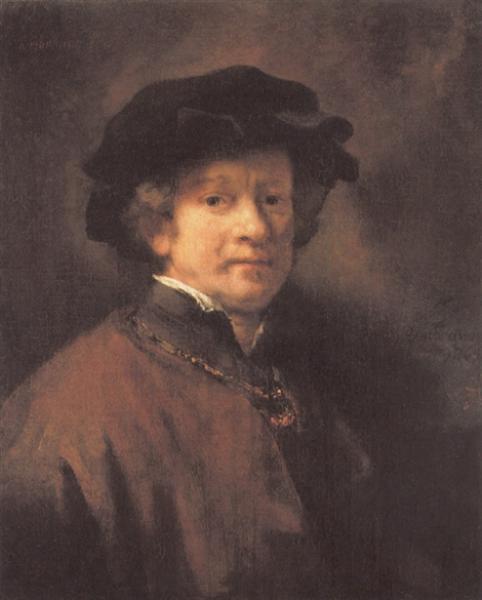Popis
The painting "Self-Portrait" from 1654, a masterpiece by the celebrated Dutch painter Rembrandt van Rijn, is a fascinating study not only of the artist's painting technique, but also of his inner psychology and worldview. This self-portrait, one of many images Rembrandt made of himself throughout his life, is presented with an emotional depth that sets it apart from other contemporary portraits. In it, Rembrandt is shown in close-up, with his face illuminated by a golden light that highlights the almost sculptural quality of his skin and allows us to appreciate every detail and nuance of his expression.
The composition is notable for its asymmetry and the way the artist handles pictorial space. Rembrandt chooses a dark background that contrasts with the luminosity of her face and clothing. This use of chiaroscuro, a technique that uses intense differences between light and shadow, not only gives dominance to her figure, but also contributes to the introspective atmosphere of the work. When looking at the painting, the viewer feels almost like an intruder in an intimate moment, which creates a personal connection with the artist.
Colour plays a fundamental role in the representation of the author's identity. Rembrandt uses a palette of warm, earthy tones, predominantly ochres and browns, which accompany the texture of his hair and clothing. This contrasts slightly with the paler tone of his skin. The choice of clothing, a dark coat and a white collar, invites us to think of the fashion of his time, but, above all, reinforces his authorial presence. Each fold of the fabric is executed with a virtuosity that speaks of his technical mastery.
A defining aspect of this self-portrait is Rembrandt’s gaze. His eyes, filled with depth and a mix of melancholy and self-knowledge, seem to contemplate not only the viewer but also his own existence. This self-knowledge is vital, as the artist was facing a series of personal tragedies, including the loss of his wife and several children. These biographical aspects are intertwined with the portrayal of a compelling sense of human experience, one of the most powerful characteristics of his work.
Rembrandt is known for his ability to portray the human condition in all its complexity. This self-portrait, therefore, is not just an image of himself, but a reflection of his soul, a psychological self-portrait that invites contemplation. In a broader context, it is an example of the Baroque, an artistic period that sought to intensify emotional expression and the use of space.
Compared to other self-portraits of his time, such as those of his contemporary Diego Velázquez or portraits by authors such as Albrecht Dürer, Rembrandt's portrait is characterized by its humility and sincerity. Rather than presenting an idealized image of himself, he offers an honest view that delves into the emotions and challenges of his own life.
The "Self-Portrait - 1654" is not only a testament to Rembrandt's technical skill, but also an invitation to explore the human soul in its rawest and most authentic form. The intimacy it manages to convey establishes a bridge between the author and the viewer, making us reflect on the nature of art, life and memory. Ultimately, this work is a legacy of the complexity of the human being and a celebration of the self-understanding that so defined Rembrandt's work.
KUADROS ©, a famous painting on your wall.
Hand-made oil painting reproductions, with the quality of professional artists and the distinctive seal of KUADROS ©.
Painting reproduction service with satisfaction guarantee. If you are not completely satisfied with the replica of your painting, we will refund 100% of your money.

